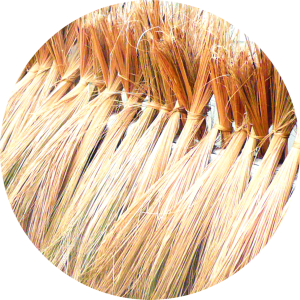
FIBRA D’AGAVE / CABUYA
L’ Agave è una pianta grassa originaria del Messico, le cui fibre sono usate dalle popolazioni locali per fabbricare corde.
Queste fibre sono lavorate in modo originale da ogni famiglia, che si tramandano disegni e colori di generazione in generazione.
AGAVES FIBRE (Cabuya)
Agaves is a succulent plant from Mexico, its fibres are used by local people to produce ropes. These fibres are handled in an original way by each family that passes down drawings and colours from generation to generation
FIBRA DE AGAVE (Cabuya)
El ágave es una planta crasa originaria de México, cuyas fibras usan las poblaciones locales para fabricar cuerdas. Estas fibras son trabajadas en modo original por cada familia, transmitiendo diseños y colores de generación en generación.
TAGUA
Tagua conosciuta anche come cade, avorio vegetale, mococha, corozo, è il seme di una palma (Phytelephas Macrocarpa) che cresce nei boschi tropicali del Nord del Perù, del Sud della Colombia e dell’Ecuador, che singolarmente produce circa il 95% della tagua commercializzata nel mondo.
Di colore marrone all’esterno e bianco all’interno, i semi di tagua, noti per la loro durezza e resistenza, sono usati per creare manufatti di alta qualità e bellezza. Gli artisti e gli artigiani che utilizzano questo materiale raffigurano soprattutto animali e piante, oltre che a figure d’ispirazione precolombiana.
TAGUA
The Tagua, also knows as cade, plant ivory, mococha, corozo, is the seed of a plant (Phytelephas Macrocarpa) that grows in the tropical woods of north Peru, south Colombia and Ecuador, it singularly produces about the 95% of the tagua that is sold in the world.
Brown outside and white inside, the tagua seeds that are famous for their hardness and resistance, are used for the creation of beautiful and high quality hand made products. The artists and artisans who use this material, represent above all animals and plants, in addition to figures of pre-Colombian inspiration.
TAGUA
Tagua conocida también como cadde, marfil vegetal, mococha, corozo, es la semilla de una palma (Phytelephas macrocarpa) que crece en los bosques tropicales del Norte de Perù, del Sur de Colombia y de Ecuador, éste último produce aproximadamente el 95% de la tagua comercializada en el mundo.
De color café al exterior y blanco en su interior, las semillas de tagua, conocidas por su dureza y resistencia, se usan para crear manufacturas de alta calidad y belleza. Los artistas y los artesanos que utilizan este material realizan figuras que representan sobre todo animales y plantas, además de figuras de inspiración precolombina.


LANA DI LAMA
Colores de Sudamerica propone l’artigianato dell’Asociación de Llamingueros Intiñan, un’associazione di allevatori di Lama il cui obiettivo è favorire il ripopolamento di questa specie all’interno del comprensorio andino, permettendo così, alla popolazione locale e alle comunità indigene della provincia di Riobamba (Ecuador), di riscoprire le preziose risorse che tali straordinari animali possono offrire.
LLAMA WOOL
Colores de Sudamerica proposes the handicraft of the Asociación de Llamingueros Intiñan, a llama breeders association whose objective is to repopulate the Andean area with these species in order to give the possibility to the local people and to the indigenous communities of the provinces of Riobamba (Ecuador) to rediscover the valuable resources that these extraordinary animals can offer.
LANA DE LLAMA
Colores de Sudamérica propone artesanía de la Asociación de Llamingueros Intiñan, una asociación de criaderos de llama cuyo objetivo es de favorecer la repoblación de esta especie en el interior del comprensorio andino, permitiendo así, a la población local y a las comunidades indígenas de la provincia di Riobamba (Ecuador), de redescubrir los preciosos recursos que estos extraordinarios animales pueden ofrecer.
CARTA RICICLATA
Prodotta dal gruppo Manos Creativas nella provincia ecuadoriana di Manabi’, questa carta è ottenuta dalla macerazione e dall’essicazione di materiale di scarto (come carta da ufficio) e fibre di varie piante.
RECYLED PAPER
It is produced by the group Manos Creativas in the Ecuadorean area of Manabi’. This paper is obtained from the maceration and drying of scrap material (such as office paper) and various plant fibres.
PAPEL RECICLADO
Producido por el grupo Manos Creativas en la provincia ecuatoriana de Manabí, este papel se obtiene de la molienda y secado de papel de oficina y fibras de varias plantas.


PAGLIA TOQUILLA
La paglia toquilla deriva dalle foglie della palma Carludovica palmata, coltivata soprattutto nelle zone costiere dell’Ecuador, ed è famosa per essere la materia prima con cui gli artigiani confezionano a mano i Montecristi Hat/Sombreros Montecristi, conosciuti come Panama Hat.
TOQUILLA STRAW
Toquilla straw comes from the leaves of the Carludovica palmata palm tree that is grown above all in the coastal areas of Ecuador and it is famous for being the raw material that is used by the artisans to craft the Montecristi Hat/Sombreros Montecristi, also known as Panama Hat.
PAJA TOQUILLA
La paja toquilla deriva de las hojas de la palma Carludovica palmata, cultivada sobre todo en las zonas costeras del Ecuador, y es famosa por ser la materia prima con la que los artesanos tejen a mano los Montecristi Hat/ Sombreros Montecristi conocidos como Panama Hat.
COCCO
Il legno della noce di cocco è un materiale molto resistente e leggero utilizzato per produrre utensileria, oggetistica e anche gioielli.
COCONUT
The coconut wood is a very resistant and light material and it is used to produce tools, objects and also jewels.
COCO
La madera de la nuez de coco es un material muy resistente y ligero utilizado para producir utensilios, adornos y joyas.

